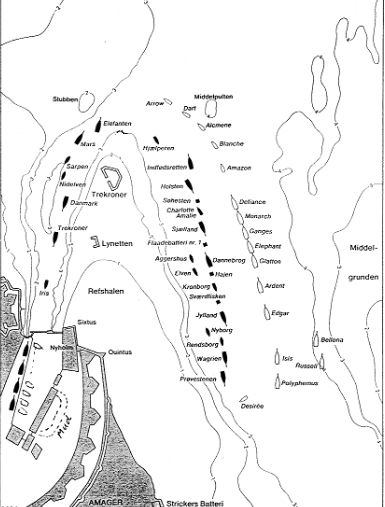
PLAN SHOWS POSITIONS OF FORTS AND VESSELS.
| THE BATTLE OF COPENHAGEN - BACKGROUND During the winter of 1800/1801, Britain faced a hostile attitude from Russia, Prussia, Sweden and Denmark. This posture culminated in those combined countries declaring ‘armed neutrality’ against Britain. In turn, this served to bolster Napoleon’s continental blockade of British trade. In March of 1801, a fleet of 53 ships under Sir Hyde Parker, set sail to enforce Britain’s command. Although 18 of the fleet were ships of the line, still they were outnumbered by the combined fleets of the Northern powers. Their only hope would be if they could attack each navy separately. Parker was old and somewhat lacking in aggression. Fortunately for Britain, however, his second-in-command was none other than Nelson - probably one of the greatest fleet commanders of all time. Once in the Baltic, Parker acquiesced to Nelson’s more dynamic ideas. He allowed Nelson to take the smaller British ships into combat with the Danish fleet, moored off Copenhagen, before they had a chance to combine with the Russians and Swedes. It was no doubt expected that an attack on the Danish fleet would be well defended by the Trekroner Fort, strategically placed to defend the harbour and environs of Copenhagen. As usual, however, Nelson defied convention and took his warships through some dangerously shallow water so that he could attack from an unexpected quarter. The tactic worked extremely well and although the battle was hard fought, the British prevailed. The capitulation of the Danes forced the other members of the armed neutrality to think again. That action, together with the continued presence of a British fleet in the Baltic, is very probably the reason the ‘armed neutrality’ would soon dissolve into just a memory. |

PLAN SHOWS POSITIONS OF FORTS AND VESSELS.
Danish List (Langton Danish Models available)